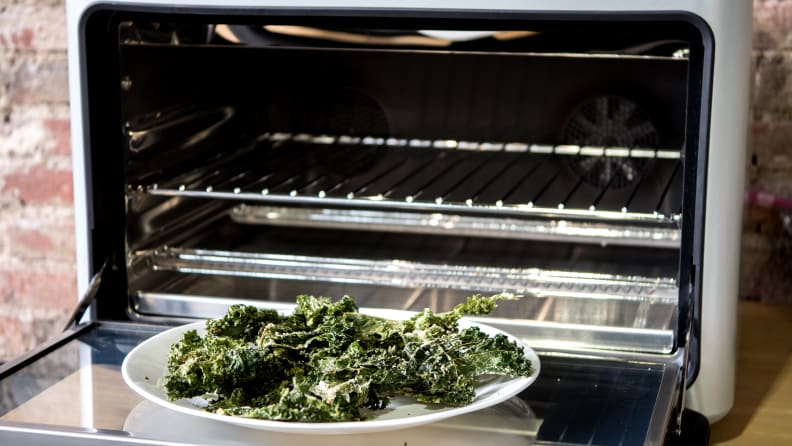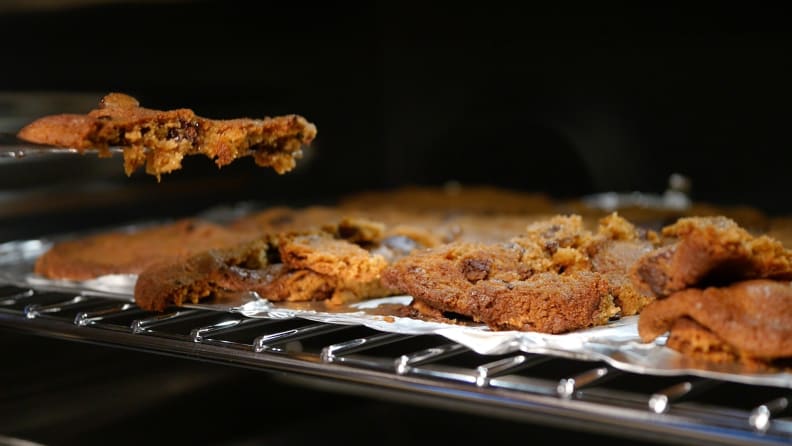I cooked dinner in a $1,500 toaster. Here's what happened.
It's been called the future of cooking. We put it to the test.
 Credit:
June
Credit:
June
Products are chosen independently by our editors. Purchases made through our links may earn us a commission.
When the folks behind the June smart oven offered to send a prototype to the Reviewed.com test labs, I jumped at the chance. The WiFi-connected countertop oven is one of the most talked-about smart home gadgets of 2016—and not just because of its $1,500 pricetag.
June’s creators say that it uses advanced algorithms, cameras, and preset recipes to recognize foods and automatically select and adjust recipes. An advanced heating system ensures precise temperature control, and a smartphone app lets users remotely program the oven and monitor their food.

The June Oven looks great, and has a responsive touchscreen.
More importantly, however, June’s creators say that the oven is aimed at neophyte cooks like myself—the sort of people who wouldn’t mind letting software take over if it meant perfect dinners and desserts every time. So I went grocery shopping and told my coworkers not to bring a lunch, because I’d be cooking for them.

Since the June only has a single rack, you can only bake one batch of kale chips at a time.
If the June succeeded, it would be proof that smart cooking is just around the corner—a bet that some wealthy Silicon Valley types made when they ponied up $22.5 million in funding for June earlier this year.
If the June failed, I’d have to face an office full of hungry, angry people—and the realization that technology may not be able to solve every problem.
The Promise
June is one of a handful of new smart cooking devices—like the Innit guided cooking platform, the Drop smart scale, and smart ovens from Anova and Tovala—that claim they’ll act like a virtual sous chef, using the latest technology to help get dinner on the table.
The Google, Apple, and GoPro alums who created June claim that it can make even the most reluctant chef excited about cooking. “June’s got your back,” the oven’s website promises. “Tackle more complicated recipes. Juggle more dishes at once.”

The kale chips were delicious — but took 55 minutes to finish.
Those promises resonated with me. Like a lot of people who live alone, I often find it easier to rely on fatty takeout food and sodium-laden frozen dinners than to cook a meal for one from scratch. If June really worked, it might be just what I needed to start cooking fresh, healthy food in my own kitchen.
To put it to the test, I decided to make an entire meal from scratch for my coworkers. Armed only with raw kale, chicken breast, steak, chocolate chip cookie dough, and June’s automated expertise, I was going to find out if June was truly smart—or just a giant, $1,500 toaster.
The Tests
And it certainly is giant. The 1.0-cu.-ft. oven might not have enough room to cook multiple racks of cookies at once, but it still took up a decent swath of countertop—which is the one resource most tech-savvy, urban-dwelling singles lack. At least it looks good: The clear glass door and bright touchscreen display do, indeed, appear more futuristic than any appliance I’ve seen.
After connecting it to a WiFi network, June took a few seconds to download a software update. While that might seem superfluous, June’s ability to grow and improve its recipe database is one of the product’s key selling points—so I forgave the interruption.
As promised, June’s built-in camera recognized a baking sheet full of raw kale, and the touchscreen immediately asked me if I wanted to make kale chips. “Sure,” I thought, and instructed the oven to start.
I’ve made kale chips before, and I knew that they tend to take anywhere between 20 and 30 minutes. June, however, had other plans: As soon as I started the cooking program, the timer shot up to 55 minutes, and there was no way to adjust it. I could either wait an hour and have kale chips, or stop the program and have a handful of warmed, raw kale.
While my coworkers loved the finished product, they weren’t happy that the chips arrived almost a half hour after I expected them to be done. If June had only offered an estimate of how long the recipe would take—an update the company says it has in the works—I would’ve been able to better plan my meal.

The chicken recipe takes 9 minutes. The timer will go off in 22 seconds. The chicken won't be done until it reaches 165ºF. Huh?
More of the oven’s flaws came to light during my second course, which was a choice of either chicken or steak. In both cases, the smartphone app showed a time estimate that differed from the June’s on-screen display by as much as 15 minutes.
The issue was particularly a problem when cooking steak. While the on-screen app showed a countdown for when the entire recipe would be complete, only the smartphone app included instructions for when to turn the steak over. Even then, it barely gave me more than a few seconds’ notice for each step in the recipe.

The menu says "Live Video" — but it's really just a still photo that updates whenever you open the app.
In other words, imagine a cookbook that only showed one step at a time. If anything, June was increasing my kitchen anxiety.
Although the process was imperfect, at least the steak, chicken, and kale chips tasted alright. However, that wasn’t the case for cookies:

Somehow, June made cookies that were both underdone and burnt. They tasted horrendous.
While June recognized a baking sheet of cookies and promised to cook them automatically, the program ran for just 12 minutes at 220ºF. Since the dough was still raw, I put them in for another round—and ended up with cookies that were at once burnt and underdone. My coworkers agreed: They were inedible.
The Verdict
I spoke with the folks at June shortly after I finished testing to let them know the issues I had with the oven. They assured me that the cookie incident was an isolated one—the result of a bug that has since been fixed. Similarly, they told me that the app would soon be updated to include recipe time estimates, to include up to 60 more recipes, and to better sync with the built-in touchscreen.
As we talked, it became increasingly clear that the the software powering June remains a work in progress. Even though June already missed its target ship date of spring 2016, some key functions still won’t be available until after software updates, which June said would take place sometime in 2017.

These two alerts show just how confusing the June's timer setup is.
For instance, all June’s current recipes are time based. Despite the included camera and processing power, the oven simply follows preset recipes, automatically changing temperatures and cook modes after a set amount of minutes pass. (Recipes that require the oven’s built-in temperature probe do take temperature into account.) Recipes that adapt are coming in 2017—but launch customers will have to wait for a software update.
Perhaps the biggest disappointment, however, is less about technology and more about philosophy.

I still had to look at a cookbook to learn how to prepare the chicken.
{{ amazon name="Our favorite toaster: The Panasonic Flash Xpress", asin="B008C9UFDI", align="right" }} I didn’t gain any transferable knowledge during my time cooking with June. It didn’t teach me how to debone those chicken breasts, it didn’t give me any hints on how to season the kale chips, and it didn’t tell me how long I should bake the cookies if I wanted them a little extra crispy—the way I like them. Instead, June only told me when I had to perform a task that the oven couldn’t automate—like flipping a steak.
Remember, June costs $1,500. That’s more than 15 times the cost of one of the best countertop ovens on the market. If I were truly interested in learning to cook, I’d rather subscribe to a meal kit startup. Even if I messed up a Blue Apron recipe, I’d at least walk away with some skills.
Cooking with June, however, felt a lot like reheating one of my frozen dinners—and you can buy a lot of those for $1,500.
